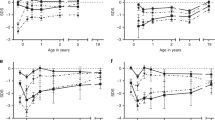Abstract
Objective
The aim of this research is to compute a prediction of the future intelligence of every neonate with a meningomyelocele (MMC) on the day of birth to inform the parents. Earlier research revealed that the variables ventricle size, open arch above vertebra lumbar 3, a very small or a very large head can be attended by an IQ below 85 points: the turning point between dependence and independence.
Methods
Until now no research has been done combining the values of influencing variables in one equation. Our study used the equation of multiple longitudinal linear regression. For reference, data from the files of 148 neonates born in the years 1960–1980 were compared with those of Dutch children sampled by Verger. The working hypothesis that the IQ level is directly related to congenital deformities of the nervous system needs to be tested. As standard the values of variables at birth, the head circumference and length, the size of the ventricles and the highest open vertebral arch, are to be used.
Results
The Wisc-R of the MMC cohort had a mean of 84 points and 55% had an IQ above 85. The correlation computation of the values of all available variables with the values of the measured Wisc-R revealed the significance of the neuroanatomical variables, size of ventricle and level of the highest open vertebral arch and for the anthropomorphic variables Length and Length/Circumference. To establish the relationship between the Wisc-R value and the values of the significant variables an equation with the multiple linear regression method was used. The measured IQ is made dependent on the significant variables size of ventricle, level of highest open arch and quotient Length by Circumference. This equation produces a value called predicted IQ. The predicted IQ was 92%, the same or nearly the same as the measured Wisc-R IQ.
Conclusion
This conformity of the measured IQ and the predicted IQ proves the possibility of using these birth data for prediction.


Similar content being viewed by others
References
Beeker TW, Scheers MM (1998) Factors related to intelligence in meningomyelocele. Eur J Pediatr Surg 8 [Suppl 1]:73
Hunt GM (1999) Non-selective intervention in newborn babies with open spina bifida: the outcome 30 years on for the complete cohort. Eur J Pediatr Surg 9 [Suppl 1]:5–8
Laurence KM, Evans RC, Weeks RD, Thomas MD, Frazer AK, Tew B (1976) The reliability of prediction of outcome in spina bifida. Dev Med Child Neurol Suppl 37:150–156
Lonton AP (1982) Prediction of intelligence in spina bifida neonates. Z Kinderchir 37 [Suppl 1]:172–174
Lorber J (1961) Systemic ventriculographic studies in infants born with meningomyelocele and encephalocele. The incidence and development of hydrocephalus. Arch Dis Child 36:381–389
Miyan J, Sobkowiak C, Draper C (2001) Casey Holter essay 2001. Humanity lost. Eur J Pediatr Surg 11 [Suppl 1]:54–59
Verger WJM (1996) Pediatric morphometrics. Bunge, Maarssens
Author information
Authors and Affiliations
Corresponding author
Rights and permissions
About this article
Cite this article
Beeker, T.W., Scheers, M.M., Faber, J.A.J. et al. Prediction of independence and intelligence at birth in meningomyelocele. Childs Nerv Syst 22, 33–37 (2006). https://doi.org/10.1007/s00381-004-1128-7
Received:
Published:
Issue Date:
DOI: https://doi.org/10.1007/s00381-004-1128-7




